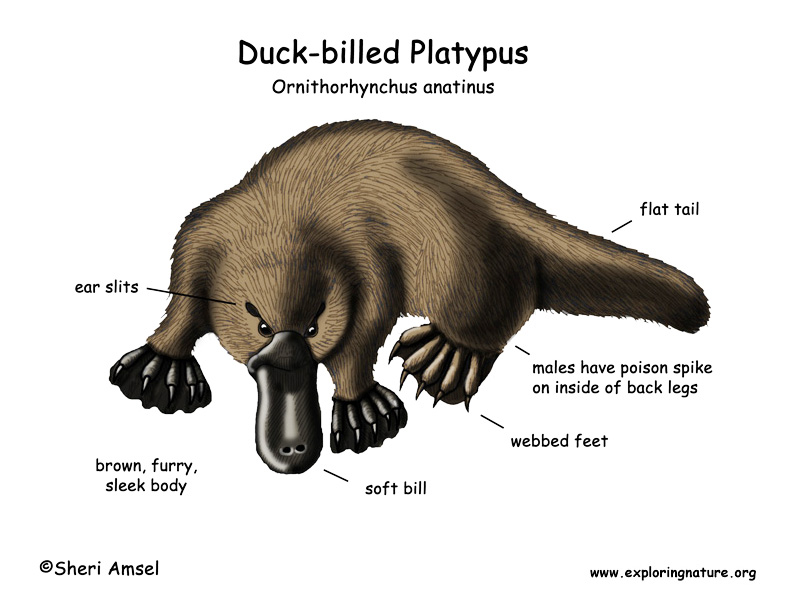

They are found in Australia and Tasmania.
They live in and near lakes, rivers, and coastal waterways.
They have a furry, sleek, brown body, lighter underneath with webbed feet, a big, wide tail and a soft bill. They are about 2 feet long and weight about 6 pounds. They have a thick outer coat that is waterproof and a warm under fur.
They are active mostly at night (nocturnal) and in the dawn and dusk. The male has a sharp, poisonous spur on the inside part of each back leg with which it can poke enemies. They live in burrows in riverbanks and are good swimmers.
They eat worms, insects, small crabs, tadpoles, and shrimp, etc. They have no teeth but mash prey in their bill.
They are eaten by dingoes, wild cats, large lizards, pythons, crocodiles, hawks and eagles.
The females dig a burrow nest and lay 1 - 3 soft-shelled eggs. She warms them (incubates) for 10 days until they hatch and then they nurse milk from their mother out of 'milk patches' on her belly.
They can live 10 - 15 years in the wild. They are listed as Near Threatened.
Kingdom: Animalia
Phylum: Chordata
Subphylum: Vertebrata
Class: Mammalia
Order: Monotremata
Family: Ornithorhynchidae
Genus: Ornithorhynchus
Species: Ornithorhynchus anatinus
When you research information you must cite the reference. Citing for websites is different from citing from books, magazines and periodicals. The style of citing shown here is from the MLA Style Citations (Modern Language Association).
When citing a WEBSITE the general format is as follows.
Author Last Name, First Name(s). "Title: Subtitle of Part of Web Page, if appropriate." Title: Subtitle: Section of Page if appropriate. Sponsoring/Publishing Agency, If Given. Additional significant descriptive information. Date of Electronic Publication or other Date, such as Last Updated. Day Month Year of access < URL >.
Amsel, Sheri. "Platypus (Duck-billed)" Exploring Nature Educational Resource ©2005-2024. December 13, 2024
< http://www.exploringnature.org/db/view/Platypus-Duck-billed >

